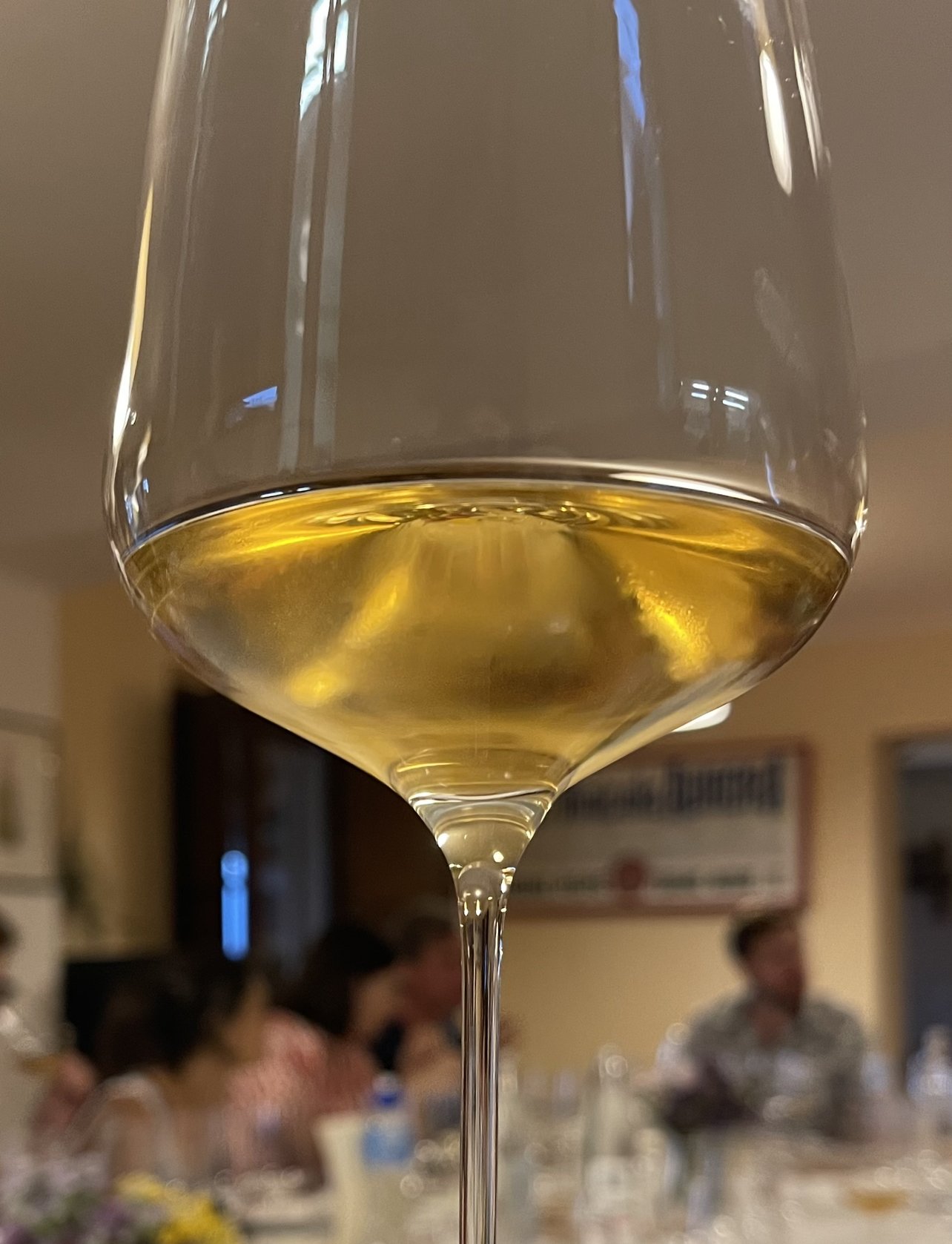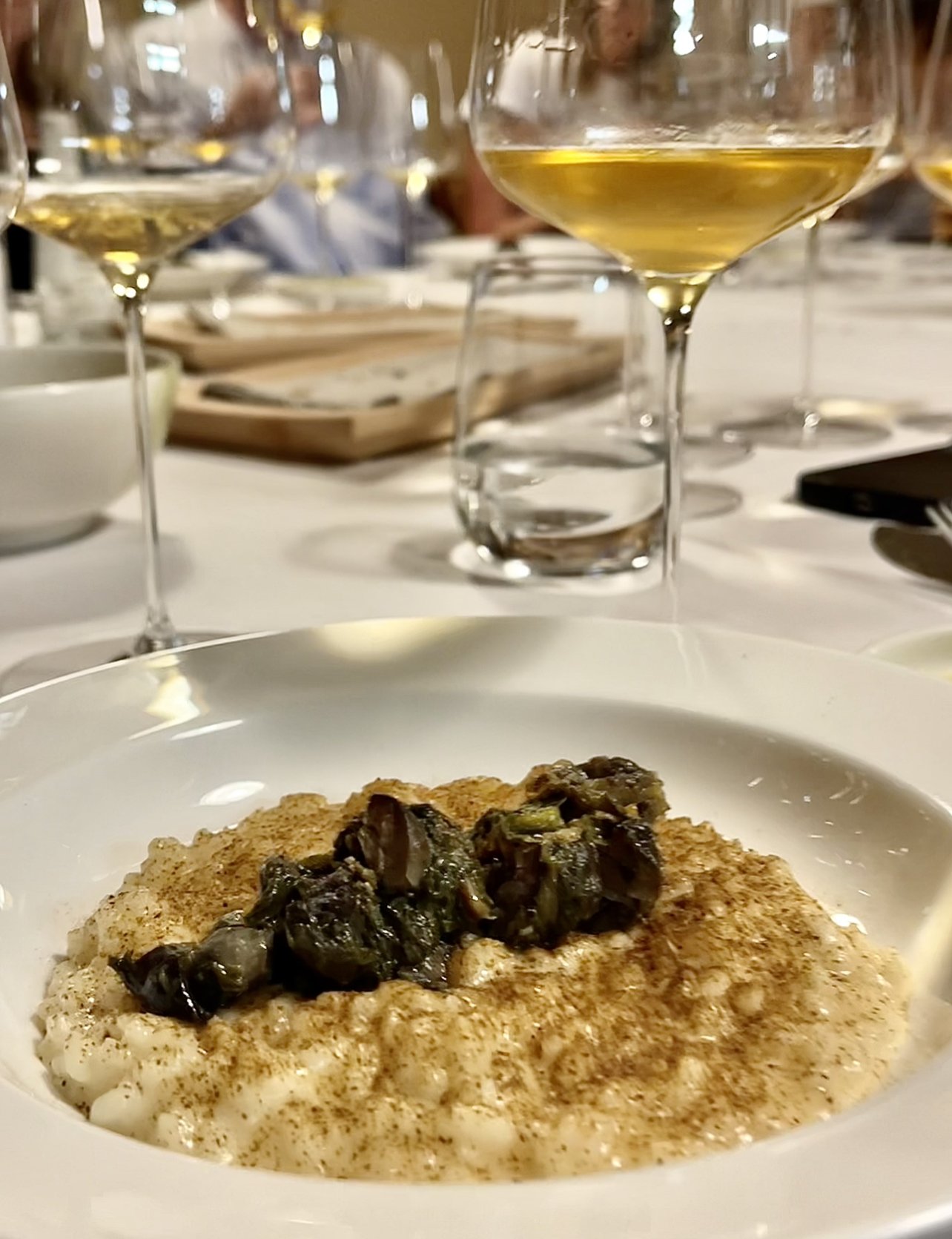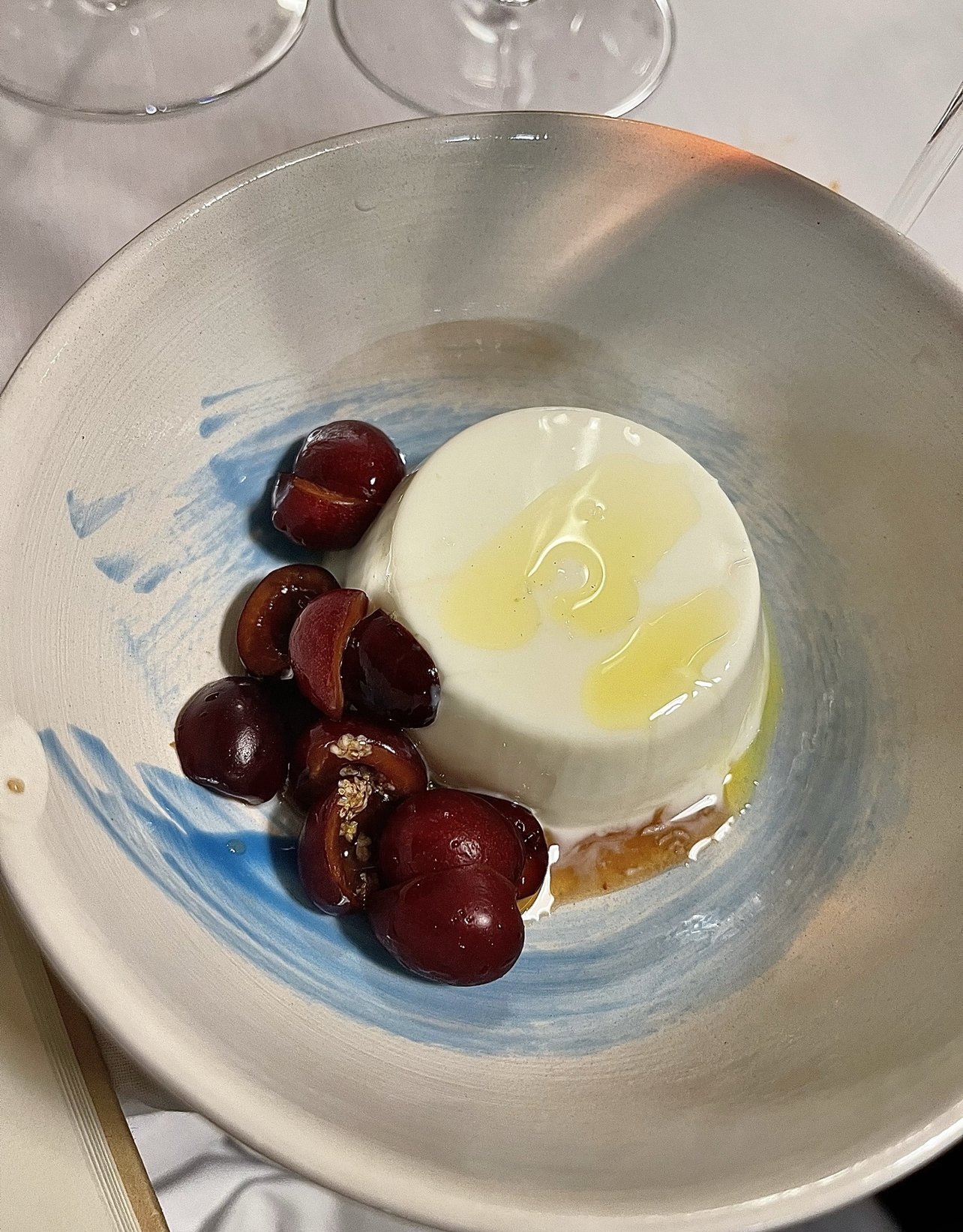Emidio Pepe Winery: A Tale of Tradition
/In June of 2022, I was a member of a journalists’ group excursion to Emidio Pepe winery in Abruzzo, Italy. The eye-opening visit to the winery’s vineyards and cellar was followed by a unforgettable wine-pairing dinner at the family’s on-site restaurant.
All photos by Lisa Denning.
As our busload of approximately 20 wine writers meandered toward one of Italy's renowned wineries, a weathered sign at the side of the narrow, windy road appeared, signaling our proximity. With the words "Vini Pepe" inscribed on it and an arrow guiding the way, anticipation grew for the experience that awaited us.
Setting foot on the premises, I was instantly struck by its timeless charm. The unassuming buildings stood guard over a spectacular Abruzzo landscape of green hills gently rolling along a stunning backdrop of the Gran Sasso mountains.
A figure emerged from the distance, walking up the driveway with a warm smile. It was Emidio Pepe himself, accompanied by his daughter Sofia, who affably greeted us. Joining them soon after was Pepe's granddaughter, Chiara, who would take us on a tour of the vineyards and cellar before hosting us for a delightful dinner. Before the tour began, we had the opportunity to chat and take photos with the amiable Mr. Pepe, whose affection for his family was evident.
Emidio and Sofia.
Emidio and Chiara.
From Vines to Bottles
Founded in 1899 in the province of Teramo, the Pepe family estate initially cultivated high-yielding grapes for local co-ops. In 1964, Emidio Pepe, the third generation, began crafting fine wine to bottle under his own name. A true visionary, he recognized the exceptional aging potential of Trebbiano and Montepulciano d'Abruzzo before many others did and poured all his passion into these two indigenous grape varieties.
It wasn’t long before his wines began getting noticed by wine critics and enthusiasts alike, and today, Emidio Pepe wines are considered some of Italy's most age-worthy, legendary wines.
2015 Issue of Gambero Rosso.
The estate is now managed by Sofia, who oversees the cellar operations, and Chiara, who tends the vines. However, Emidio, now 91, remains on hand, doling out his invaluable wisdom, and can often be found during the early mornings at work in the vineyards.
Their story is one of dedication and a deep connection to the terroir, which has allowed the estate to flourish and captivate wine enthusiasts worldwide.
In the Vineyards: Embracing A Human Touch
Our group’s first stop, led by Chiara, was to the vineyards. The genuine love for her work shone through as she explained how the absence of technology in the vineyards allows her to connect with nature and observe subtle changes that only attentive human eyes can detect.
Along with a small vineyard team, Chiara spends significant time immersed in the vines, embracing nature's rhythms and intricacies. While modern tools are available to monitor factors like humidity and rainfall, she said, the heart of their approach lies in walking the vineyards and closely observing the plants.
"Human sensibility is a part of agriculture that cannot be replaced," emphasizes Chiara. "At Emidio Pepe, everyone has grown closer to the vineyards, deepening their connection to the land and the vines."
On Biodynamics
A pioneering figure in Italy's biodynamic viticulture, Emidio Pepe has embraced holistic farming methods for decades, achieving Demeter certification for the winery in 2006.
Biodynamic farming treats the vineyard as a holistic ecosystem connected to the universe. Unlike conventional winemaking, biodynamic practices rely solely on natural elements, eschewing artificial chemicals and additives. The soil is nurtured with a blend of natural products like copper crystals and mined sulfur, along with biodynamic preparations such as fermented herbs and minerals which stimulates plant vitality.
"I feel incredibly grateful to have been handed fully alive soils that have never seen any pesticides whatsoever,” shared Chiara. “Biodynamic farming is a way to protect ourselves, work better, and protect the environment.”
One example Chiara shared is the use of milk in the vineyard. “Milk becomes anti-fungal when exposed to light,” she explained. “Spraying water and milk in full daylight creates a more acidic surface on the leaves, inhibiting disease development."
“It’s hard for people to believe in the power of biodynamics,” says Chiara, “until they experience firsthand the direct connection between human effort and the vine’s response. When you rise at 5:00 in the morning and witness the changing light and observe how our small actions impact the vines, it’s truly awe-inspiring.”
Biodiversity
Unlike conventional farming, biodynamics champions biodiversity, and for over 50 years, Emidio Pepe has been an advocate of this approach. Of their 27 hectares, 17 are dedicated to vines, while the remaining ten flourish with trees, bushes, and diverse crops.
"Grandfather and his family have always been cultivating different things,” explained Chiara. “More than ever, it's our responsibility to maintain a diverse landscape because it enriches the soil and creates a system much stronger than a monoculture that only has vines. We have many plants and trees on our property, and in addition to vines, we cultivate chickpeas, spelt, sunflowers, and 200 different kinds of wheat.”
Cellar
Our tour continued into the heart of the cellar, where Pepe's unwavering faith in the wines' aging potential drove him, over the years, to carefully preserve hundreds of bottles from every vintage. The winery’s annual production of approximately 80,000 bottles is mostly Trebbiano and Montepulciano, with small amounts of Pecorino (white wine) and Cerasuolo d’Abruzzo (rosé wine specific to Abruzzo).
The winemaking process follows a natural path with minimal intervention. The grapes are hand-harvested, hand-destemmed, fermented with natural yeasts, and aged in large glass-lined cement tanks, some dating back to Emidio Pepe’s early days. The wine is aged 18 to 24 months before being bottled, unfined and unfiltered. The bottled wine continues to mature in the cellar for years, if not decades.
For the white Trebbiano grapes, wooden boxes are used for traditional foot-treading, during which, as Chiara explained, the grapes rapidly develop their distinctive aromatic characteristics. Afterward, the skins and stems undergo gentle extraction in a basket press before the wine is aged in concrete tanks, followed by lengthy bottle aging.
wooden boxes used to foot-tread the white grapes.
For its red wine, Montepulciano d’Abruzzo, a delicate elegance in its weight and density is aimed for. This is done by entirely eschewing the use of wooden barrels and avoiding excessive grapes extraction, which can lead to heavy, tannic wines. The grapes are de-stemmed on a net so that only the berries, not the bitter stems, fall into a wooden vat. A basket press is used to press the grapes, with a team member regularly tasting the juice to monitor the process. Following fermentation, the wines are aged in concrete tanks before bottling.
“Concrete represents one of the cornerstones of our production’s philosophy. Concrete tanks are the home of the wine, its natural habitat, a neutral and hospitable place that leaves the wine free to express itself without external influences..” —EmidioPepe.com
The winery also grows a small amount of Pecorino, an indigenous grape variety from the south of Marche and the north of Abruzzo that makes full-bodied whites.
Crafting Wines for Two Markets
The Emidio Pepe cellar conducts two separate bottlings: one for the local (Italian) market and another for export. The local wines are made from younger vines and undergo less extraction and shorter aging, highlighting their youthful and vibrant nature. Conversely, wines for the export market are produced from older vines and receive extended maturation, which adds to the wine’s complexity and structure. These long-aged wines are released to the market only when the family thinks that the vintage is at its best expression. To eliminate any confusion, the winery has added “Selezione Vecchie Vigne" to the front label of the older vine wines since the release of the 2010 vintage.
Dinner
As the evening unfolded, Chiara's warm hospitality continued durig dinner at the family’s restaurant, where we experienced firsthand the culmination of their efforts, a beautifully curated meal paired with a wide range of Emidio Pepe wines. Each sip and bite of every wine offered a glimpse into the soul of the winery, showcasing the flavors and essence of Abruzzo. The dinner included a rare 40-year-old Montepulciano, whose lively character revealed firsthand the enduring quality of the wines.
A Word on Trebbiano and Montepulciano d’Abruzzo
Trebbiano d’Abruzzo is an ancient, indigenous grape from Abruzzo, a unique clone different from other Italian Trebbiano. Its beautiful acidity and aromatic balance make it a fine wine with complexity. It has an elegant, austere expression when young with great minerality. Yet it is truly age-worthy and able to evolve with time; after a few years, it gains complexity, volume, and depth. The Emidio Pepe Trebbiano wines we tasted at the dinner, 2009 and 2004, were golden-hued with nuanced notes of nuts, hay, and yellow fruits.
Montepulciano d’Abruzzo is known as “the king” of Abruzzo’s red varieties. Emidio Pepe describes the grape as the “wine of the future for its immediate beauty and aging potential.” The winery’s Montepulciano stands apart from its counterparts in the region, boasting a robust and distinctive character bursting with flavors of dried black cherries, licorice, and wild herbs. Amazingly, the fruity and liveliness of these wines remained present even in these older vintages (we tasted 2007, 2003, 2002, 2001, and 1983).
Timeless Craftmanship
Emidio Pepe wines are revered for their complexity and longevity, but they also serve as a reminder that wine is more than just a beverage—it's a culmination of generations of craftsmanship and a deep respect for nature. Here, time-honored traditions, biodynamic practices, and human sensibility intertwine to produce wines of unparalleled quality.
A heartfelt thank you to the Consortium for Wines of Abruzzo for organizing the Abruzzo tour and to the Pepe family for their gracious hospitality.
Planning a trip to Abruzzo? You, too, can experience the full charm of Emidio Pepe winery with its inviting accommodations, on-site restaurant, and wine tastings. To learn more, visit EmidioPepe.com.










































